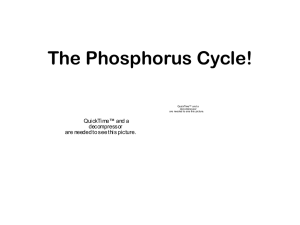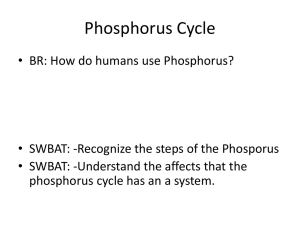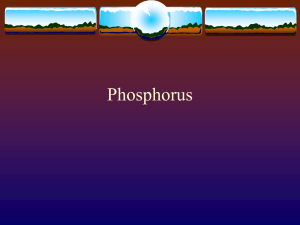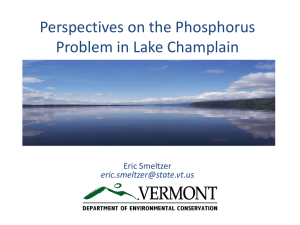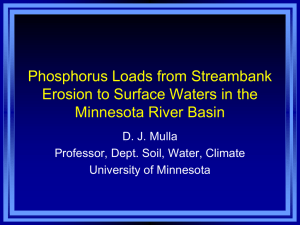The adoptability of perennial-based farming systems for hydrologic
advertisement
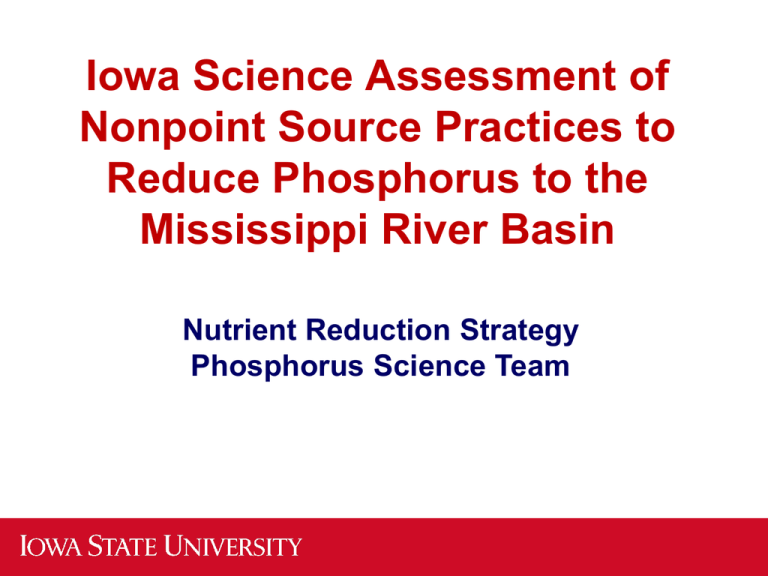
Iowa Science Assessment of Nonpoint Source Practices to Reduce Phosphorus to the Mississippi River Basin Nutrient Reduction Strategy Phosphorus Science Team Nutrient Reduction Strategy Phosphorus Science Team • • • • • • • • • • Jim Baker – IDALS/ISU Reid Christianson – ISU Rick Cruse – ISU John Kovar – USDA-ARS Matt Helmers – ISU Tom Isenhart – ISU Antonio Mallarino – ISU Keith Schilling – IDNR Calvin Wolter – IDNR Dave Webber - ISU Approach 1. Establish baseline – existing conditions – Major Land Resource Areas used to aggregate conditions 2. Extensive literature review to assess potential performance of practices – Outside peer review of science team documents (practice performance and baseline conditions) 3. Estimate potential load reductions of implementing nutrient reduction practices (scenarios) – “Full implementation” and “Combined” scenarios 4. Estimate cost of implementation and cost per pound of nitrogen and phosphorus reduction Approach • The P evaluation primarily focused on practices that limit or control P losses from agricultural land. • Does not include known sources of P such as point sources, leaking rural septic systems, and stream bank erosion. ISU NREM USDA NRCS Approach • Stream banks are known to be a potentially large source of suspended and bedded sediments. • Estimated contributions ranging from 40 to 80% of annual sediment loads in Midwestern streams. • Accurate accounting is difficult. Isenhart et al. Unpublished Practice Review Process • Established an overall list of potential practices based on input of overall science team • Shortened the list to those expected to have greatest potential for nutrient reduction through detailed discussion of P team – reviewed by overall science team • New and emerging practices could be added in future Practice Review Process Phosphorus Reduction Strategies Excluded Due to Very Limited Impact or Not Information at this Point • • • • • • • • Timing of phosphorus application Living mulches (e.g. kura clover) Green manure No continuous soybean Shallow drainage Drainage water management Bioreactors Two-stage ditches Practice Review Process P reduction practices fall into three main groups 1. P Management Practices • • • • • 2. Application Source (commercial fertilizer, manure) Placement Cover crops Tillage Land use change • Crop choice • Perennial vegetation 3. Erosion Control and Edge of Field Practices • • • • Terraces Wetlands Buffers Other erosion control Practice Review Process • Extensive review of literature from Iowa and surrounding states – Used Iowa and surrounding states to try to have similar soils and climatic conditions – Reviewed and compiled impacts phosphorus concentrations and loads – Reviewed and compiled impacts on corn yield • Summarized expected practice performance Nitrogen or Phosphorus? Nitrogen moves primarily as nitrate-N with water Phosphorus moves primarily with eroded soil Phosphorus Reduction Practices • Practices were compared with a corn-soybean rotation – P needed by the two crops surface-applied once after soybean harvest in the fall before soils freeze – Tillage includes chisel plowing cornstalks after harvest and disking/field cultivating in the spring before planting soybeans – Before planting corn the normal practice is disking/field cultivating in the spring Phosphorus Management Practices Phosphorus Application Rate • P rate is less important than N rate as it affects water quality • P rate affects the STP level, so historical P application rates and current STP level are important for impacts on water quality • Application rate is of great concern when any manure type is applied at N-based rates • Load reduction was estimated using Iowa P Index comparing rates of 200 kg P2O5 ha-1 (max), and 125 kg P2O5 ha-1 (avg.) compared to the average annual removal for a corn-soybean rotation of 62 kg P2O5 ha-1. • Estimates in bracket are “worst case scenarios” in which a rainfall occurs within 24 hours of P application Practice Phosphorus Application Comments Applying P based on crop removal – Assuming optimal STP level and P incorporation % P Load Reduction Min Avg. (SD) Max 0 [0] 0.6 [70] 1.3 [83] Phosphorus Management Practices Soil Test Phosphorus Level • Phosphorus loss can be reduced by decreasing total soil P concentration • This practice assumes limiting or stopping P application to high-testing soils until STP is lowered to agronomically optimum concentrations of 20 ppm for corn and soybean production • Load reduction was estimated using Iowa P Index for a 5 Mg ha-1 erosion rate • Maximum load reduction was estimated by comparing P loss with an STP of the two highest counties in IA (125 ppm) to the optimum (20 ppm) STP level • Average load reduction was estimated based on reducing the average STP of all counties in IA (40 ppm) to the optimum STP level • Estimates in brackets are from unpublished work by Mallarino (2011) Practice Phosphorus Application Comments Soil-test P – No P applied until STP drops to optimum % P Load Reduction Min Avg. (SD) Max 0 [35] 17 [40] 52 [50] Phosphorus Management Practices Site-Specific P Management • Site-specific management that considers the P loss risk from different areas of a field could be a beneficial practice to reduce P loss • Not well studied, but research in IA has found variable-rate fertilizer and manure P application to be effective in reducing within field variability of STP levels • The approach used to estimate P load reduction was the same as for the STP practice and used mean values from a recent unpublished study by Mallarino that included the mean proportion of IA STP classes for each field Practice Comments % P Load Reduction Min Phosphorus Application Site-specific P management 0 Avg. (SD) Max 14 Phosphorus Management Practices Source of Phosphorus • There is little evidence of P source (i.e. fertilizer compared to manure P) effects shortterm delivery from fields if the P is incorporated into the soil • In the long term, manure can reduce runoff compared to inorganic P forms by increasing soil organic carbon • If runoff-producing rainfall events occur immediately after application, less P loss occurs with solid beef and poultry manure compared with commercial fertilizer Practice Source of Phosphorus Comments % P Load Reduction Min Avg. (SD) Max Liquid swine, dairy, and poultry manure compared to commercial fertilizer – Runoff shortly after application -64 46 (45) 90 Beef manure compared to commercial fertilizer – Runoff shortly after application -133 46 (96) 98 Phosphorus Management Practices Placement of Phosphorus • Subsurface banding of P or incorporation of surface-applied P fertilizer or manure on sloping ground reduces P loss significantly compared with surface application when runoff-producing precipitation occurs shortly after application • Estimates in brackets are from a report by Dinnes (2004) and are the author’s best professional judgment Practice Placement of Phosphorus Comments % P Load Reduction Min Avg. (SD) Max Broadcast incorporated within 1 week compared to no incorporation, same tillage 4 36 (27) 86 With seed or knifed bands compared to surface application, no incorporation -50 24 (46) [35] 95 [-20] [70] Phosphorus Management Practices Cover Crops • Cover crops reduce erosion by improving soil structure and providing ground cover as a physical barrier between raindrops and the soil surface Practice Cover Crops Comments Winter Rye % P Load Reduction Min Avg. (SD) Max -39 29 (37) 68 Phosphorus Management Practices Tillage • Tillage practices affect soil erosion, the primary process for P delivery in IA • Tillage effects on P loss are site specific, but less P loss generally occurs with minimum or no tillage compared with conventional tillage • No-till can increase the proportion of total P lost as dissolved P, especially in tiledrained areas Practice Tillage Comments % P Load Reduction Min Avg. (SD) Max Conservation till – chisel compared to moldboard plowing -47 33 (49) 100 No-till compared to chisel plowing 27 90 (17) 100 Land Use Change Crop Choice • There is very little P loss data for specific extended rotations compared to a cornsoybean rotation in IA Perennial Vegetation • Perennial vegetation established as energy crops or land retirement would significantly reduce soil erosion and P loss • Delivery of P to water bodies is highly affected by pasture management Practice Comments % P Load Reduction Min Crop Choice Perennial Vegetation Extended Rotation Energy Crops Max -13 Land retirement (CRP) Grazed Pastures Avg. (SD) 34 (34) 79 75 2 59 (42) 85 Erosion Control and Edge-of-Field Practices Buffers • Designed to reduce P delivery by removing particulate P from runoff through filtration and sedimentation and reducing dissolved P by plant uptake or soil binding • Riparian buffers can also stabilize stream banks Erosion Control • Designed to reduce sediment delivery • Includes sedimentation basins, drop structures, ponds, etc. Practice Comments % P Load Reduction Min Avg. (SD) Max Terraces 51 77 (19) 98 Buffers -10 58 (32) 98 75 85 95 Erosion Control Sedimentation basins or ponds Phosphorus Reduction Practices Phosphorus Management Practice % Phosphorus-P Reduction [Average (Std. Dev.)] Producer does not apply phosphorus until STP drops to optimal level 17 (40) Source (Liquid swine compared to commercial) 46 (45) Incorporation 36 (27) No-till (70% residue) vs. conventional tillage (30% residue) Perennial – Land retirement Land Use Edge-of-Field 90 (17) 75 (-) Cover Crops (Rye) 29 (37) Pasture 59 (42) Buffers 58 (32) *Load reduction not concentration reduction P-Index Model P-Index Inputs for Erosion Component • • • • • • Gross Erosion rate (tons/acre/yr) Landform Region (Sediment Delivery ratio) Distance from Stream Buffer Distance Enrichment Factor (Tillage/No till) Soil Test Phosphorus content (ppm P) Gross Erosion Estimate • • • • • • • • RUSLE model A = R * K * LS * C * P A = annual soil loss (tons/yr) R = rainfall erosivity factor K = soil erodibility factor LS = length slope factor C = cover factor P = practice factor County Data from NRCS Distance Categories to NHD Stream Network • • • • • • • 0 – 500 ft 500 – 1,000 ft 1,000 – 2,000 ft 2,000 – 4,000 ft 4,000 – 8,000 ft 8,000 – 16,000 ft > 16,000 ft Data from SSURGO • K Factor (soil erodibility factor) • Slope • Slope Length Cover Factor • Use Crop Rotation information from NASS CDL • Use Tillage Practice information from CTIC • 7-8 combinations for each MLRA • Use Section I-C-1 from SCS-Iowa 1990 to obtain Cover Factor and LS Factor Practice Factor • • • • Contour Strip Cropping Terraces Contour Strip Cropping and Terraces Use Section I-C-1 from SCS-Iowa 1990 to obtain Practice Factor Gross Erosion Calculation • A = R * K * LS * C * P • Perform RUSLE calculation for each cropping rotation/tillage combination in each distance class in MLRA P-Index Model P-Index Inputs for Runoff Component • • • • • Landcover condition (crop and residue) Dominant Soil type Soil Test Phosphorus content (ppm P) Fertilizer Application Rate (lb P2O5/acre) Fertilizer Application Method Dominant Soil Type in MLRA Distance Classes • • • • • K Factor KSat Factor (Saturated Conductivity) Slope Slope Length Find Soil Type that matches all factors the closest P-Index Input for Drainage Component • Tile Drained soil • Well Drained soil Result of P-Index Model • Phosphorus loss in lbs/ac/year for each crop rotation/tillage/buffer distance combination • Sum up all combinations for MLRA to obtain total Phosphorus Loss for MLRA • Perform for each individual management practice and combinations Phosphorus Practices – Potential Load Reduction Target Load Reduction from NPS for Hypoxia Goal ~29% Phosphorus Reduction Scenarios Scenario: Not applying P on acres with high or very high Soil-Test P (RR) • This practice involves not applying P on fields where STP values exceed the upper boundary of the optimum level for corn and soybean in Iowa (20 ppm, Bray-1 or Mehlich-3 tests, 6-inch sampling depth). This practice would be employed until the STP level reaches the optimum level. • Practice limitations, concerns, or considerations • Limitation to utilization of manure-N. When manure is applied, use of the P Index (which considers STP together with other source and transport factors) to assess potential impact of N-based manure on P loss is a reasonable option considering farm economics and other issues. • Landlord/tenant contracts often require maintaining STP levels, even if higher than optimum. Scenario Phosphorus P rate reduction in MLRAs that Management have high to very high soil test P Phosphorus Potential Area Reduction (million acres) (% from baseline) 7 25.8 Phosphorus Reduction Scenarios Scenario: Inject/Band P in All No-Till Acres (IN) • This practice involves injecting liquid P sources (fertilizer or manure) and banding solid inorganic fertilizers within all current no-till acres. • Practice limitations, concerns, or considerations • For inorganic P fertilizers, it adds to the costs and does not increase (nor reduce) yield in Iowa. • Possible benefits of injecting or banding inorganic P fertilizer containing N by improving N use efficiency. • For liquid manure, this is a good practice to use manure-N efficiently. • For solid manure, there is no practical way to do it yet, but engineering advances for prototypes being evaluated could make it practical in the future. Scenario Phosphorus Injection/band within no-till acres Management Phosphorus Potential Area Reduction (million acres) (% from baseline) 0.3 4.8 Phosphorus Reduction Scenarios Scenario: Convert All Intensive Tillage to Conservation Tillage (Tct) • This practice involves the conversion of all tillage acres to conservation tillage that covers 30 percent or more of the soil surface with crop residue, after planting, to reduce soil erosion by water. • Practice limitations, concerns, or considerations • No clear data concerning impacts of this type of conservation tillage on possible corn yield reduction compared with moldboard plowing. However, data suggests the yield reduction is minimal in most conditions. • These reduced tillage practices are significantly less efficient than no-till at controlling soil erosion and surface runoff. Scenario Phosphorus Convert all intensive tillage to Management conservation tillage Phosphorus Potential Area Reduction (million acres) (% from baseline) 11 8.6 Phosphorus Reduction Scenarios Scenario: Convert All Tilled Area to No-Till (Tnt) • This practice involves the conversion of all tillage to no-till, whereby the soil is left undisturbed from harvest to planting except for strips up to 1/3 of the row width made with the planter (strips may involve only residue disturbance or may include soil disturbance). This practice assumes approximately 70 percent or more of the soil surface is covered with crop residue, after planting, to reduce soil erosion by water. • Practice limitations, concerns, or considerations • No-till results in lower corn yield than with moldboard or chisel-plow tillage. However, the yield reduction is less or none for other minimum tillage options that, on the other hand, are less efficient at controlling soil erosion and surface runoff. • No-till or conservation tillage does not affect soybean yield significantly. Scenario Phosphorus Convert all tillage to no-till Management Phosphorus Potential Area Reduction (million acres) (% from baseline) 39 16.1 Phosphorus Reduction Scenarios Scenarios: Plant a rye cover crop on all corn-soybean and continuous corn acres (CCa) Plant a rye cover crop on all no-till acres (CCnt) • The cover crop in this practice/scenario is late summer or early fall seeded winter cereal rye. • Practice limitations, concerns, or considerations • • • • • • Impact on seed industry due to increased demand for rye seed. Row crops out of production to meet rye seed demand. New markets for cover crop seed production and establishment. Livestock grazing. Corn and soybean planting equipment designed to manage cover crops in no-till. Negative impact on corn grain yield for species with spring growth. Scenario Phosphorus Cover crops (rye) on all CS and Management CC acres Cover crops on all no-till acres Phosphorus Reduction (% from baseline) Potential Area (million acres) 50 21.0 4 4.8 Phosphorus Reduction Scenarios Scenario: Establishing 35 foot buffers on all crop land (BF) • Buffers have the potential to be implemented adjacent to streams to intercept overland flow and reduce P transport to receiving waters. Scenario Edge-of-Field Establish streamside buffers (35 ft.) on all crop land Phosphorus Potential Area Reduction (million acres) (% from baseline) 18 0.4 Phosphorus Reduction Scenarios Scenario: Perennial Crops (Energy Crops) Replacing Row Crops (EC) • This scenario switches corn and soybean row crop land to energy crops at the amount equivalent to reach the total number of acres in pasture/hay in 1987 for each MLRA. Row crop acres were reduced proportionally for the corn-soybean rotation and continuous corn. • Practice limitations, concerns, or considerations • Immediate limited market for perennials as energy crops. • Market shifts in crop prices and demand. Scenario Land Use Change Perennial crops (Energy crops) equal to pasture/hay acreage from 1987. Take acres proportionally from all row crop. This is in addition to current pasture. Phosphorus Potential Area Reduction (million acres) (% from baseline) 29 5.9 Phosphorus Reduction Scenarios Scenario: Grazed Pasture and Land Retirement Replacing Row Crops (P/LR) • This scenario increases the acreage of pasture and retired land to equal the pasture/hay and retired land acreage in 1987, which was the first time land was enrolled in the Conservation Reserve Program (CRP). Row crop acres were reduced proportionally for corn-soybean rotation and continuous corn. • Practice limitations, concerns, or considerations • Market and price shifts due to reduced row crop production. • New markets for grass-fed beef. Land Use Change Scenario Phosphorus Reduction (% from baseline) Potential Area (million acres) Pasture and Land Retirement to equal acreage of Pasture/Hay and CRP from 1987 (in MLRAs where 1987 was higher than now). Take acres from row crops proportionally. 9 1.8 Phosphorus Reduction Scenarios Scenario: Extended Rotation (corn-soybean-alfalfa-alfalfa-alfalfa) (EXT) • This scenario Increases the acreage of extended rotations by doubling the current amount of extended rotations (and reducing proportionally the corn-soybean rotation and continuous corn) in each MLRA. • Practice limitations, concerns, or considerations • • • • Reduce the amount of corn and soybean produced in Iowa. Market shift in product production (more alfalfa) and associated price for crops produced. Increased livestock production to feed alfalfa. Market shift as little fertilizer N is needed for corn following alfalfa. Scenario Land Use Change Doubling the amount of extended rotation acreage (removing from CS and CC proportionally) Phosphorus Reduction (% from baseline) Potential Area (million acres) 3 1.8 Phosphorus Reduction Scenarios Scenario Phosphorus Potential Area Reduction (million acres) (% from baseline) Cover crops (rye) on all CS and CC acres 50 21.0 Convert all tillage to no-till 39 16.1 Convert all intensive tillage to conservation tillage 11 8.6 4 4.8 7 25.8 0.3 4.8 Phosphorus Cover crop (rye) on all no-till acres Management Phosphorus rate reduction in those MLRAs that have high to very high soil test phosphorus Injection within no-till acres Target Load Reduction from NPS for Hypoxia Goal ~29% Phosphorus Reduction Scenarios Scenario Edge of Field Phosphorus Potential Area Reduction (million acres) (% from baseline) Buffers (35 feet) on all crop land 18 0.4 Perennial crops (Energy crops) equal to pasture/hay acreage from 1987. Take acres proportionally from all row crop. This is in addition to current pasture. 29 5.9 Pasture and land retirement to equal Land Use pasture/hay, and CRP acreage from 1987 Change (in MLRAs where 1987 was higher than now). Take acres from row crops proportionally. 9 1.9 Doubling the amount of extended rotation acreage (removing from CS and CC proportionally). 3 1.8 Target Load Reduction from NPS for Hypoxia Goal ~29% Combined Phosphorus Reduction Scenarios Examples! Combination Scenarios P Reduction Nitrate-N Reduction (% from (% from baseline) baseline) Scenario Practice/Scenario PCS1 Phosphorus rate reduction on all ag acres (CS,CC,EXT, and pasture)/Conservation tillage on all CS and CC acres/Buffers on all CS and CC acres 30 7 PCS2 Phosphorus rate reduction on 56% of all ag acres (CS,CC,EXT, and pasture)/Convert 56% of tilled CS and CC acres to No-Till/Buffers on 56% CS and CC acres 29 4 PCS3 Phosphorus rate reduction on 53% of all ag acres (CS,CC,EXT, and pasture)/Convert 53% of tilled CS and CC acres to No-Till/Cover crops on No-till CS and CC acres 29 14 PCS4 Phosphorus rate reduction on 63% of ag acres (CS,CC,EXT, and pasture)/Convert 63% of tilled CS & CC acres to No-till and cover crops on No-till crop acres except for MLRAs 103 and 104 29 9 PCS5 Phosphorus rate reduction on 48% of ag acres (CS,CC,EXT, and pasture)/Convert 48% of tilled CS and CC acres to No-till with Cover Crop on No-till acres /Buffers on 48% CS and CC acres 29 16 Combined Nitrogen and Phosphorus Reduction Scenarios Examples! Nitrate-N Practice/Scenario Phosphorus % Reduction from baseline NCS1 Combined Scenario (MRTN Rate, 60% Acreage with Cover Crop, 27% of ag land treated with wetland and 60% of drained land has bioreactor) 42 30 NCS3 Combined Scenario (MRTN Rate, 95% of acreage in all MLRAs with Cover Crops, 34% of ag land in MLRA 103 and 104 treated with wetland, and 5% land retirement in all MLRAs) 42 50 NCS8 Combined Scenario (MRTN Rate, Inhibitor with all Fall Commercial N, Sidedress All Spring N, 70% of all tile drained acres treated with bioreactor, 70% of all applicable land has controlled drainage, 31.5% of ag land treated with a wetland, and 70% of all agricultural streams have a buffer) Phosphorus reduction practices (phosphorus rate reduction on all ag land, Convert 90% of Conventional Tillage CS & CC acres to Conservation Till and Convert 10% of Non-No-till CS & CC ground to No-Till) 42 29 Future Needs Phosphorus management • Impacts on water quality of variable-rate fertilizer and manure P application technology • Development of commercially viable inorganic P fertilizer materials without N, so N and P management can be handled separately if needed • Field research based on large plots or catchments to study the impacts on P loss of alternative P management practices • Validation of the Iowa P index as an edge-of-field and watershed scale assessment tool Future Needs In-field and edge-of-field soil and water conservation practices • An efficient method to estimate ephemeral gully erosion and delivery of sediment • Water quality data comparing extended rotations, pastures, and land retirement to a corn-soybean rotation • Cover crop management techniques adapted to Iowa to limit the risk to corn yield reduction including development of new cover crop species and varieties • Direct measurement of P loss from field edge and to surface water systems • Development and evaluation of management practices to reduce stream bank erosion and sediment delivery Notes • Phosphorus assessment does not include stream bed and bank contribution • It appears that nutrient strategy reduction goals for P would be achieved under most scenarios meeting the goal for N • If considered independently from N, P goals could be achieved at lower total cost with practices implemented on an MLRA basis Summary • Process has identified practices that have greatest potential for nutrient load reduction • Process has estimated potential field-level costs associated with practice implementation and is also considering largerscale economic impacts of practice implementation • To achieve goals will require a combination of practices • N versus P requires different practices • Multiple benefits of practices will need to be considered • Knowing the starting point is still a challenge and knowing what is being done on the land could (would) improve estimates of progress that can be made Combined Phosphorus Reduction Scenarios Scenario PCS1 1. Phosphorus is not applied to all agricultural acres (CS, CC, EXT, and pasture) where STP values exceed the optimum level (20 ppm). This practice would be used until the STP level reaches the optimum level. 2. Conservation tillage is used on all CS and CC acres 3. Streamside buffers are established on CS and CC acres. Scenario PCS2 1. Phosphorus is not applied to 56% of agricultural acres (CS, CC, EXT, and pasture) where STP values exceed the optimum level (20 ppm). This practice would be used until the STP level reaches the optimum level. 2. No-till is used on 56% of tilled CS and CC acres. 3. Streamside buffers are established on 56% of CS and CC acres. Scenario PCS3 1. Phosphorus is not applied to 53% of agricultural acres (CS, CC, EXT, and pasture) where STP values exceed the optimum level (20 ppm). This practice would be used until the STP level reaches the optimum level. 2. No-till is used on 53% of tilled CS and CC acres. 3. Cover crops are used on all no-till CS and CC acres. Scenario PCS4 1. Phosphorus is not applied to 63% of agricultural acres (CS, CC, EXT, and pasture) where STP values exceed the optimum level (20 ppm). This practice would be used until the STP level reaches the optimum level. 2. No-till is used on 63% of tilled CS and CC acres and cover crops established on no-till acres, except for MLRA 103 and 104. Scenario PCS5 1. Phosphorus is not applied to 48% of agricultural acres (CS, CC, EXT, and pasture) where STP values exceed the optimum level (20 ppm). This practice would be used until the STP level reaches the optimum level. 2. No-till is used on 48% of tilled CS and CC acres and cover crops established on no-till acres. 3. Streamside buffers are established on 48% of CS and CC acres


